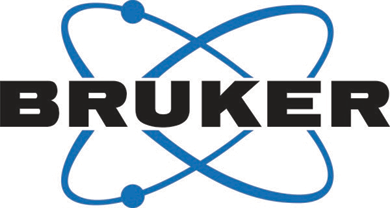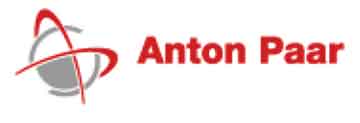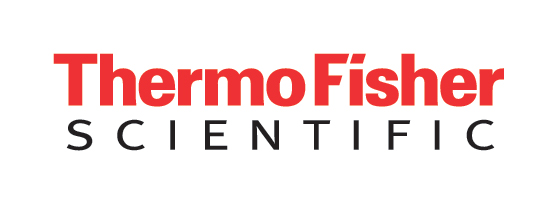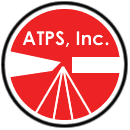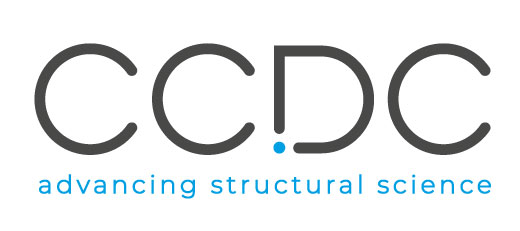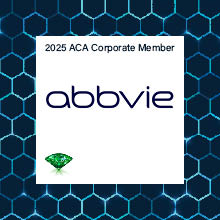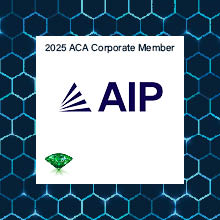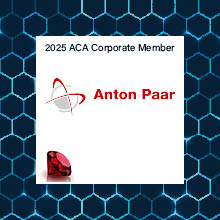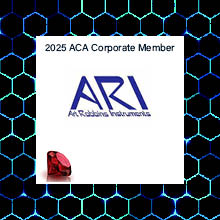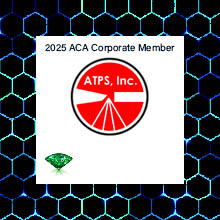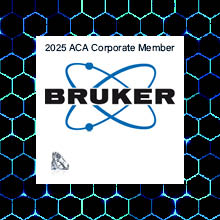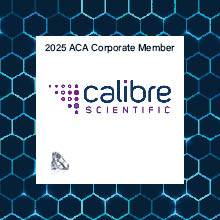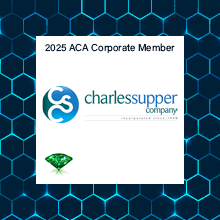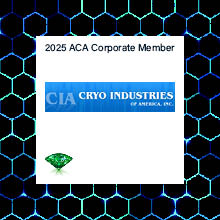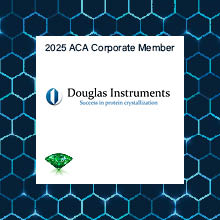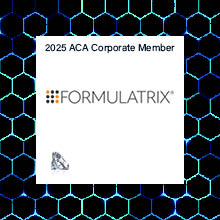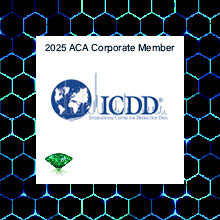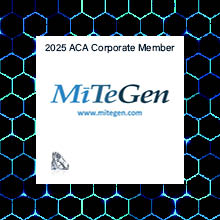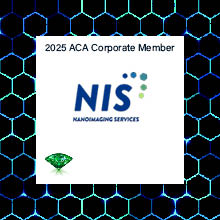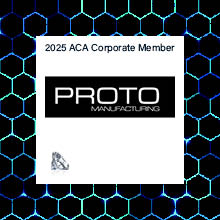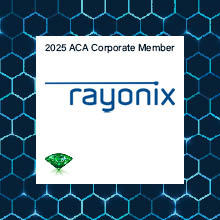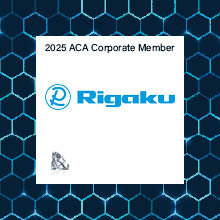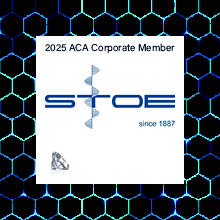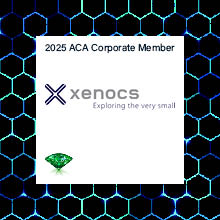|
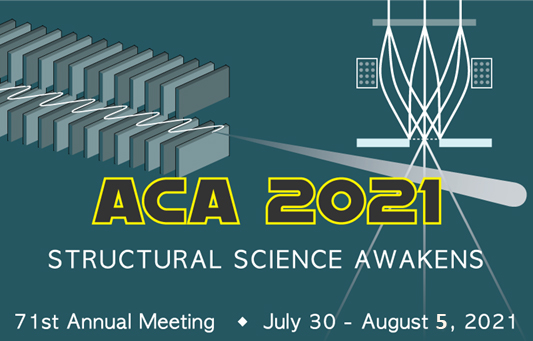 Welcome to the 2021 ACA Annual Meeting Program. The scientific program features experts from all regions of the world. Welcome to the 2021 ACA Annual Meeting Program. The scientific program features experts from all regions of the world.
Scientists with specialties in biology, chemistry, geosciences, materials science and more converged virtually for the 71st Annual Meeting of the ACA. The theme for the 2021 meeting was “Structural Science Awakens,” which celebrates the ACA’s new tagline “The Structural Science Society.” Scientific sessions and workshops highlighted new developments in single-crystal and powder diffraction, scattering, cryo-EM, micro-electron diffraction, and advanced capabilities at national x-ray, neutron, and EM facilities.
Thanks to the amazing efforts of the ACA Council, the Meeting Committee, Session Chairs, Poster Chairs and ACA Staff, as well as the hundreds of people who submitted abstracts, we had an amazing virtual experience.
2021 ACA Council Composition (As of 8/1/2021)
2021 Meeting Committee Composition
2021 Poster Chairs
2021 Corporate Members
Workshops
| |
WK1: Characterization of Soft Materials Via Small Angle Scattering: Applications of Scattering for Polymer Systems
|
|
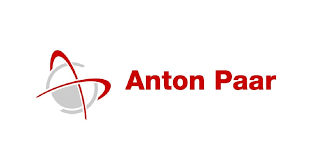
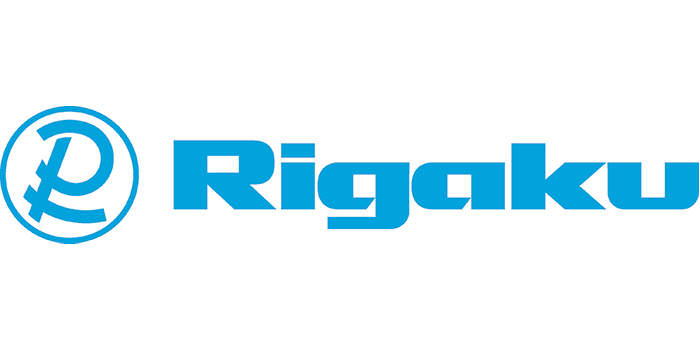
|
Organizational Contact: Thomas Fitzgibbons
X-ray and Neutron scattering are powerful tools to characterize polymer systems both in solution and in the solid state. This workshop aims to provide an introduction to scattering of polymer systems in dilute solution, interacting and self-assembled agglomerates, the melt state, and the crystalline state. We will focus on the fundamentals of small and wide angle scattering and how various analytical approaches through modeling and peak fitting can allow the user to decipher information about the polymer chains, aggregate size and shape, and crystallization behavior. The structural information gained from these scattering studies can provide insight into the properties that the macromolecules exhibit in their various applications.
Speakers/Instructors:
|
| |
WK2: Introduction to Hydroxyl Radical Footprinting Methods for Structural Analysis of Proteins and Complexes
|
| |
Organizational Contact: Corie Ralston
The solvent accessibility method of hydroxyl radical footprinting has been gaining in popularity as a complementary method to the other more widely known structural biology methods, such as crystallography, small-angle scattering, and cryoEM. The method can be used to determine structural and dynamics information on proteins in solution as a function of folding or binding, under a variety of buffer conditions, at millisecond time scales, and even in cell-like environments. In this workshop, we will first review the basics of solvent accessibility methods and how they are used to yield information on protein structure. We will then present hands-on tutorials covering data collection methods, and will take participants through the analysis of a complete footprinting dataset. Two mass spectrometry analysis software demos will be included, one from Protein Metrics Inc (PMI), and one from GenNext Technologies. Participants will be able to download the PMI software onto a PC laptop (or an Apple laptop running a virtual Windows environment) and will be provided with a test data set for practice. By the end of the workshop, participants should have an understanding of the theory behind footprinting methods, and a basic grasp of how footprinting data is obtained and analyzed.
Speakers/Instructors:
- Corie Ralston (LBNL)
- Faraz A. Choudhury (Immuto Scientific)
- Emily Chea (GenNext)
- Yan Chen (Joint BioEnergy Institute)
- Aashish Manglik (University of California)
- Cheryl Kerfeld (Michigan State)
- Michael Gross (Washington University)
- Sarah Woodson (John Hopkins University)
- Ilker Sen (Protein Metrics)
|
| |
WK3: Fundamentals of Single Particle Cryo-EM
|
|
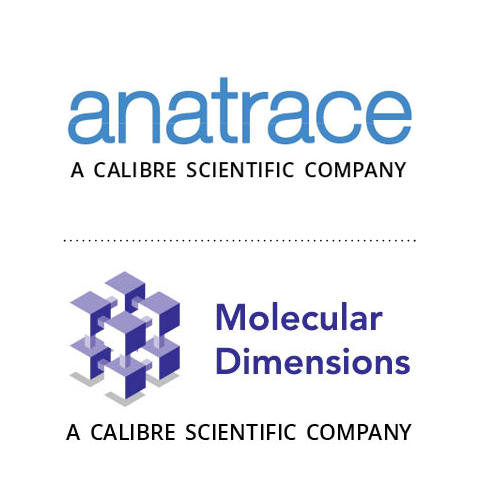



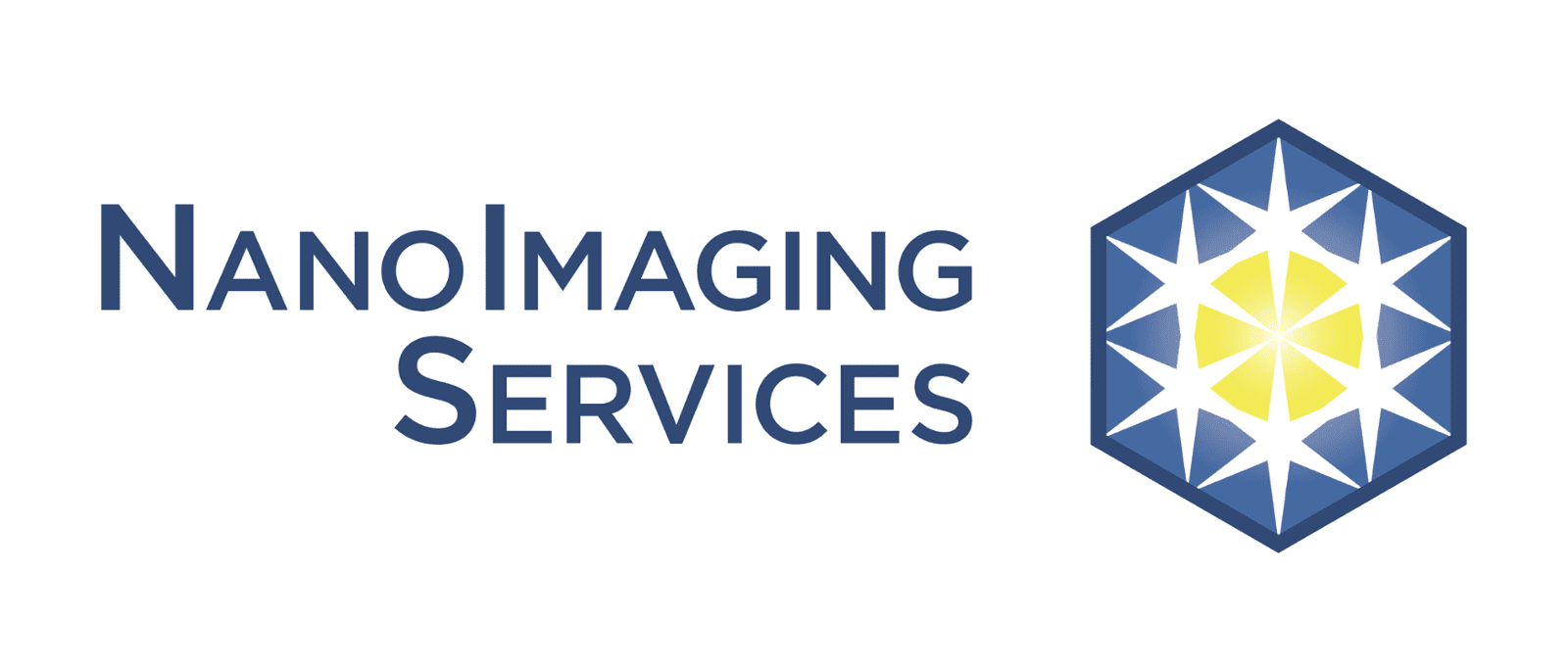
|
Organizational Contact: Mark Herzik
Cryogenic-electron microscopy (cryo-EM) has emerged as an increasingly more powerful technique to visualize frozen biological macromolecules in near-native states. Recent advances have enabled cryo-EM to deliver high-resolution density maps approaching 1.5 Å or better with maps in the 2-4 Å range now routinely being attained, informing the construction of atomic models with high confidence. This new capacity has led to increasingly more interest in adopting cryo-EM and, consequently, there is a large need for training in cryo-EM principles and methods.This workshop will focus on the fundamentals of cryo-EM and primarily benefit those who are new to the field. In this workshop, we will highlight historical advances leading to the current state of the field, provide an overview of EM sample preparation and data collection, and detail cryo-EM data processing, interpretation and validation. We will monitor a live data collection and provide tutorials on “on-the-fly” cryo-EM data processing. This workshop is a companion workshops to “Managing and Using National cryo-EM Facilities”.
Speakers/Instructors:
|
| |
WK4: Managing and Using National Cryo-EM Facilities
|
|

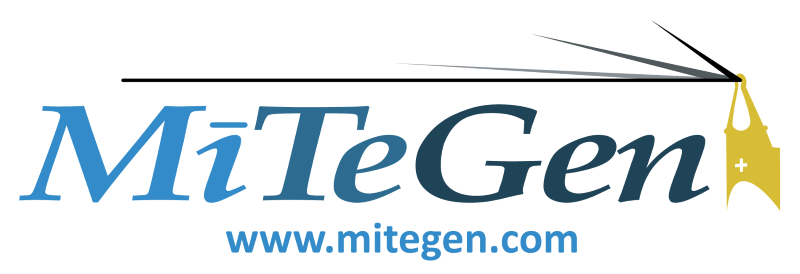

|
Organizational Contact: Ed Eng
Cryo-electron microscopy (cryoEM) is a method used to image frozen biological molecules, such as proteins and nucleic acids, without the need for structure-altering dyes or crystallization. Recent advances in cryoEM methods and technology have greatly extended its resolution and the amount of information it can provide about viruses, proteins, and other important biomolecules. CryoEM instrumentation is being installed at many universities, and is also available at large multiuser facilities both in the U.S. and worldwide. This workshop will focus on the management of multi-user cryoEM facilities. The objective is to discuss the infrastructure and operations needed to run a cryoEM facility, as well as how to interface with the NIH sponsored cryoEM national service centers.
This workshop is a companion workshop to the Fundamentals of Single Particle Cryo-EM, and will benefit those who want to use the national cryoEM centers, staff who may be in charge of cryoEM facilities, or individuals starting up new cryoEM resources and cores.
Speakers/Instructors:
|
| |
WK5: MicroED of Small and Macromolecules
|
|



|
The aim of this workshop is to provide training for microcrystal electron diffraction data collection and reduction. Topics that will be covered include sample preparation, focused ion beam milling of crystals, data collection and reduction strategies. Due to the virtual nature of the workshop, we will have seminars but no "hands-on" processing nor data collection demonstration.
Speakers/Instructors:
|
Program
|
SCHEDULE & ABSTRACTS
|

Program for PDB 50th Anniversary ACA
Transactions
Symposium 2021: Function Follows Form:
Celebrating the 50th Anniversary of the
Protein Data Bank
DAY ONE: Friday, July 30, 2021
DAY TWO: Saturday, July 31, 2021
Session Chairs: Stephen K. Burley
The 2021 ACA Meeting Transactions Symposium, entitled “Function Follows Form: Celebrating the 50th Anniversary of the Protein Data Bank,” will celebrate the 50th anniversary of the Protein Data Bank. Since 1971, 3D macromolecular structure data have been expertly archived, validated, biocurated, and safeguarded by the PDB, the first open-access digital data resource in biology. The 2021 ACA Transactions Symposium is dedicated to celebrating the manifold contributions to fundamental biology, biomedicine, bioenergy, and bioengineering/biotechnology made by PDB Data Depositors and PDB Data Consumers over the past five decades. Meeting participants working in macromolecular crystallography and practitioners of cryogenic electron microscopy, tomography, and diffraction will have the opportunity to learn first-hand from internationally recognized experts contributing to our understanding of the intrinsic relationship between 3D structure and function across the biological and biomedical sciences. Invited presentations by ten high profile experimental and computational structural biologists working in the United States, Canada, and South America will be augmented by two short talks selected from abstracts. At the close of the symposium, speakers will be invited to contribute to a short round table discussion regarding future directions in structural biology and the important role that the RCSB Protein Data Bank can play over the next 50 years.
|
|

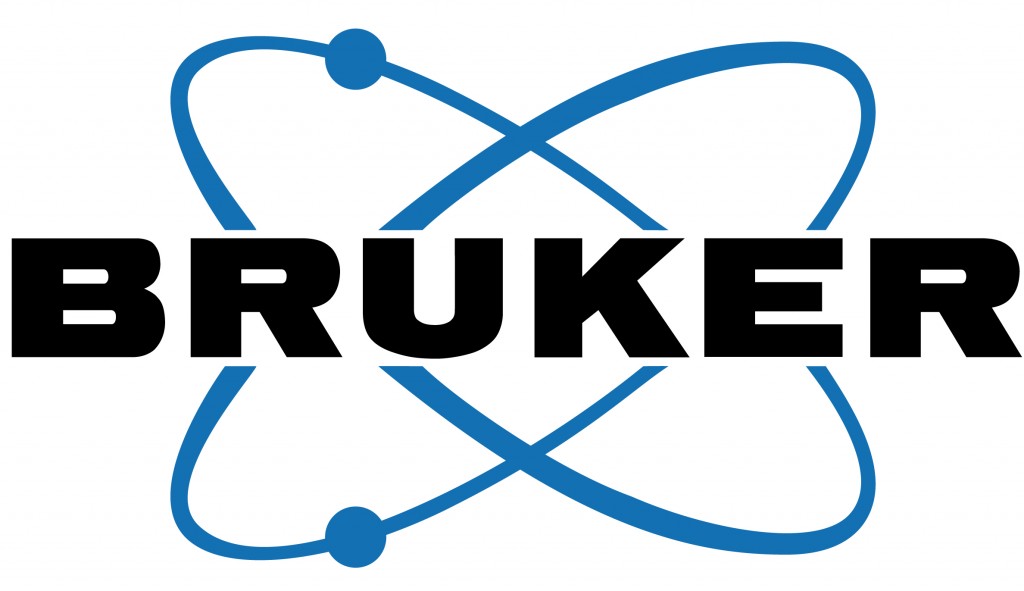

|
|
 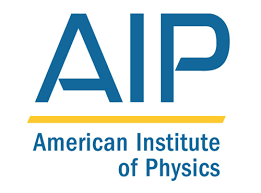
|
YSIG Speed Mentoring Session
|
|
|
1.1.4 Total Scattering: New Insights in Condensed Matter
DAY TWO: Saturday, July 31, 2021
Session Chair: Matt Tucker & Peter Metz
While crystallography has traditionally dealt with the average, periodic arrangement of atoms in condensed matter, it has long been acknowledged that deviation from ideality is critically important to understanding macroscopic material phenomena. As atomic structure characterization tools have continued to mature, an increasing body of work has accumulated documenting locally perturbed atomic environments, even in materials of nominally high average symmetry. These studies are often complemented by spectroscopy and microscopy methods to confer a nuanced understanding of materials behavior and inform the materials science paradigm.
Beyond the classical examples of diffuse scattering, total scattering and the pair distribution function have been fruitfully applied to numerous contemporary materials science problems, including: ferroic materials, catalysts, strongly correlated electron systems, energy storage materials, as well as bulk/nanoscale variations on each theme.
New experimental techniques have also advanced local structure methodologies, particularly regarding advancements in grazing incidence X-ray PDF measurements of thin films, and advancements in the quantitative treatment of electron PDF data.
This symposium invites discussion of contemporary scientific developments enabled by local structure investigations of condensed matter.
|
|
 

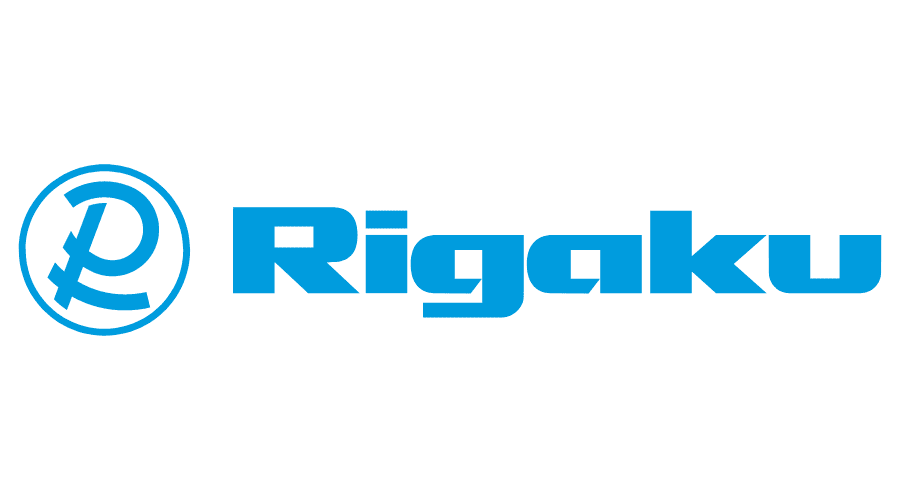


|
1.1.3 Microcrystal Electron Diffraction
DAY TWO: Saturday, July 31, 2021
Session Chairs Tamir Gonen & Xiaodong Zou
The field of microcrystal electron diffraction has rapidly progressed. Recent advances have placed microED at the forefront of structure determination. Several experimental protocols exist that describe the process of sequential sampling of diffraction patterns from nanometer-sized crystals while a sample is tilted in a transmission electron microscope. This session will be focused on advances in software/hardware and discussion of the results from microED experiments.
|
|
|
DAY TWO: Saturday, July 31, 2021
1.1.1 General Interest 1
Session Chairs: Marc Giulanotti & Brandon Mercado
General Interest sessions are the forum for topics of broad interest to the crystallographic community or for presentations that do not fit the specific theme of other sessions. All presentations are selected from submitted abstracts.
|
|

|
DAY TWO: Saturday, July 31, 2021
1.1.2 Mapping Free Energy Landscapes of Molecular Machines
Session Chairs: Kara Zielinski & Kevin Dalton
X-ray scattering, cryo-EM, NMR, and diffraction experiments probing macromolecular structure away from energy minimum, i.e. by perturbing or exploring free energy landscape (t-jump, electric field, pressure, mixing, etc).
|
|

|
DAY TWO: Saturday, July 31, 2021
Poster Session I
|
|
|
DAY THREE: Sunday, August 1, 2021
Etter Award: Julia Zaikina
Session Chair: David Rose
|
|





|
DAY THREE: Sunday, August 1, 2021
4.2.3 Sample Prep for Cryo-EM and Crystallography
Session Chair: Edward Pryor
With the technological advancements in both X-ray crystallography and Cryo-EM, structural biology techniques are becoming readily accessible to all labs. Although we are witnessing many significant strides in this field, preparation of high-quality samples still remains as one of the main bottleneck for both methods. In this session we will highlight the latest sample preparation methods, techniques, and best practices for both crystallography and Cryo-EM single particle, tomography, and micro-ED workflows.
|
|

|
DAY THREE: Sunday, August 1, 2021
1.2.1 Instrumentation for Time-Resolved Experiments
Session Chairs: Robert Henning & Gisela Brändén
Time-resolved crystallography utilizes the bunch structure of the X-ray source to probe the structural dynamics over a range of time scales (femtoseconds to seconds). This requires highly specialized instrumentation that can take advantage of these unique sources, as well as purpose-build serial crystallography setups. This session will focus on the current & future instrumentation and experimental setups that are needed at synchrotrons and XFELs to do these types of experiments. setups that are needed at synchrotrons and XFELs to do these types of experiments.
|
|
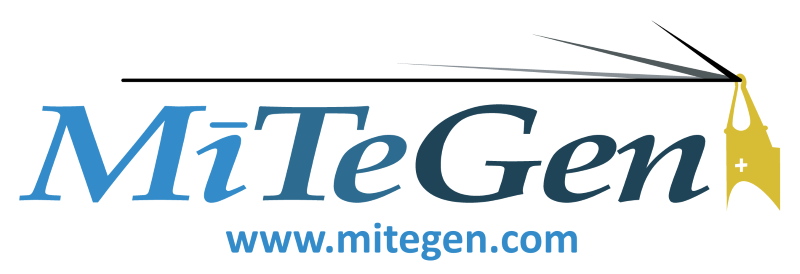
|
DAY THREE: Sunday, August 1, 2021
2.3.1 Open Exchanges in Crystallographic Education
Session Chairs: Andrew Torelli & Kraig Wheeler
Crystallographic education is vital to every aspect of our profession from the training of current and next generation scientists to the potential for shaping public perceptions. This session offers an informal platform for speakers to communicate their approaches and techniques that promote the learning process of crystallography. The short format of this session (10 minute talks) will encourage speakers and attendees to freely share ideas on focused topics that range from innovative hands-on exercises, virtual resources, and novel must-have classroom modules.
|
|
|
DAY THREE: Sunday, August 1, 2021
1.2.2 Materials for Sustainability and Energy
Session Chair: Cheng Li
Crystallography lays the foundations for understanding the structure-property relationship of functional materials for energy and sustainability. Design and optimization of materials for energy conversion and storage technologies, such as batteries, fuel cell, thermoelectrics and solar cell, relies upon insight of the crystal structure. This session will cover the latest development in the cross disciplinary fields of crystallography and materials science, so as to provide a discussion on the recent advance in the structural studies.
|
|
|
DAY THREE: Sunday, August 1, 2021
1.2.4 Redox Enzymes by Multiple Approaches
Session Chairs: Flora Meilleur & Jennifer Bridwell-Rabb
Redox enzymes are highly susceptible to radiation damage. Mitigation of X-ray induced perturbations of their metal centers or redox cofactors is key to structural investigation of their catalytic mechanisms. This session will discuss results from time resolved synchrotron, XFEL, and neutron crystallography as well as those from complementary techniques such as small angle scattering and computational calculations.
|
|
|
DAY THREE: Sunday, August 1, 2021
1.1.1 General Interest 2
Session Chairs: Victoria Drago & Brandon Mercado
General Interest sessions are the forum for topics of broad interest to the crystallographic community or for presentations that do not fit the specific theme of other sessions. All presentations are selected from submitted abstracts.
|
|

|
DAY THREE: Sunday, August 1, 2021
Poster Session II
|
|
|
DAY FOUR: Monday, August 2, 2021
BUERGER AWARD: Wah Chiu
Session Chair: David Rose
|
|

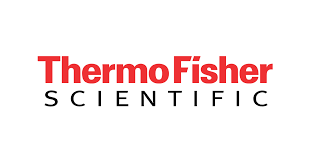
|
DAY FOUR: Monday, August 2, 2021
2.1.3 Latest Software Developments in CRYO-EM
Session Chairs: Charles Sindelar & Peijun Zhang
This session will highlight recent developments in cryo-EM software for image processing and structure analysis, including topics such as: on-the-fly processing pipelines; higher resolution single-particle and tomographic structure determination; heterogeneity analysis; 3D reconstruction in situ; molecular modeling from density maps; and micro-electron diffraction for crystallographic structure determination.
|
|

|
DAY FOUR: Monday, August 2, 2021
2.1.5 Rosalind Franklin: 101st Anniversary
Chair(s): Elspeth Garman & Joseph Orgel
Magnetic symmetry is key to understanding and designing many quantum and topological properties materials such as superconductors, quantum spin liquids, spin ices, topological insulators, chiral magnets, and skyrmions. The session will focus on various ideas on how to understand and design quantum and topological materials through magnetic and structural symmetries. We also welcome advanced magnetic and quantum characterization methods to enliven our discussions.
|
| |
DAY FOUR: Monday, August 2, 2021
2.1.4 Magnetic Structure Determination: Advances and Applications
Session Chairs: Huibo Cao & William Ratcliff
Magnetic symmetry is key to understanding and designing many quantum and topological properties materials such as superconductors, quantum spin liquids, spin ices, topological insulators, chiral magnets, and skyrmions. The session will focus on various ideas on how to understand and design quantum and topological materials through magnetic and structural symmetries. We also welcome advanced magnetic and quantum characterization methods to enliven our discussions.
|
|


|
DAY FOUR: Monday, August 2, 2021
2.1.1 Evolving Enzymes
Session Chairs: Audrey Burnim & Ben Clifton
A session encompassing reconstructed (ancient) enzymes, directed evolution of synthetic functions, and structural biology with evolutionary context.
|
 |
DAY FOUR: Monday, August 2, 2021
4.1.4 Large-Scale Facility Upgrades
Session Chairs: Ana Gonzalez, John Chrzas & Bryan Chakoumakos
Large scale light and neutron sources must undergo upgrades in order to satisfy users requirements and to remain competitive in response to the development of new state of the art sources. This session will report on some of the recently achieved and planned upgrades, the challenges to overcome and the new experimental possibilities that these projects enable in the field of diffraction based applications.
|
|





|
DAY FOUR: Monday, August 2, 2021
4.2.5 Structure-based Drug Design
Session Chairs: Anna Gardberg & Elizabeth Sprague & Hans-Peter Biemann
In this session we will feature applications of structural biology methods to drug discovery. Possible topics may include structure/function studies to inform drug discovery, hit validation, lead optimization challenges and fragments with a particular interest in examples involving a variety of techniques (e.g. x-ray, NMR, EM, in silico, biophysics, etc). Technology or methods development in these areas is also of interest.
|
 |
DAY FOUR: Monday, August 2, 2021
Poster Session III
|
 |
DAY FOUR: Monday, August 2, 2021
SPTLabtech Webinar:
Delivering complete automated solutions for integrative structural biology – from crystallography to cryo-EM
As structural biology continues to evolve rapidly to encompass a much broader range of biophysical techniques, having a complete, efficient and flexible pipeline of structural biology automation is vital to enable rapid progress to the high resolution results needed today. Democratising access to structural data puts additional options in the biochemists hands but also drives the need for ease-of-use, speed and reliability across a range of applications. In this webinar we will review the fit and function of combining SPT Labtech’s liquid handlers, our new apricot range and JanSi imaging systems provides a robust workflow for protein crystallization, added to the latest updates on our game changing chameleon system for vitrification of grids in cryo-EM and new automated methods for nL-scale chemical crystallization.
|
| |
DAY FIVE: Tuesday, August 3, 2021
2.2.5 What Can & Can't We See Reliably at Resolution X?
Session Chairs: Jane Richardson & Nigel Moriarty
Most structural biologists are familiar with what features can be seen in x-ray crystal structures of proteins in the commonest range around 2Å resolution, and have sometimes been frustrated by what we cannot see at all clearly at 3Å or worse. This session will emphasize both new studies about similarities and differences for cryo-EM (or even neutron diffraction), and also new methods that can now let us do better than expected in some cases.
|
|
|
DAY FIVE: Tuesday, August 3, 2021
2.2.1 AI, Machine Learning, and Data Science Approaches in Crystallography
Session Chairs: Thomas Proffen
Advances in machine learning (ML) and artificial intelligence (AI) are already having a revolutionizing impact in many areas such as image, speech recognition or advancing self-driving cars. These techniques are starting to have an impact in materials science and beyond. This session will provide an overview of the impact of AI, ML and related methods are having on the field of crystallography now and in the future.
|
|





|
DAY FIVE: Tuesday, August 3, 2021
2.2.4 Membrane Protein Structure in Membrane and Membrane-mimic Environments
Session Chairs: Kushol Gupta & Venky Pingali
Membrane proteins play a critical role in numerous cellular-related functions such as cell-cell signaling, molecular transport through membranes, and the anchoring of the cytoskeleton. Therefore, elucidation of membrane protein structure is essential to the understanding of their function. However, membrane proteins are not stable in aqueous buffer solutions without a stabilizing vehicle such as lipid membranes, surfactant micelles, bicelles, and even non-natural polymers. This session will present research catering to the various membrane and membrane-mimic environments employed for the study of membrane proteins, as well as the methodologies developed to expand the frontiers of the study of membrane protein structure and function.
|
| |
DAY FIVE: Tuesday, August 3, 2021
2.2.2 Computing & Data Management
Session Chairs: Herbert J Bernstein & Dale Kreitler
This is a half day session on Computing and Data Management (CDM) with talks relating to useful methods in computing and data management (not just nice results) as a companion to another half day session on Meeting the Challenges of Raw Data Management (MCRD).
CDM will focus on methods now coming to the fore in solving crystallographic structures, including advances in improving and speeding up crystallographic pipelines, advances in using models and AI in starting and managing the solution process, advances in disaggregating data from multiple conformations and states, advances in integrating results from multimodal experiments across multiple scales, etc.
|
 |
DAY FIVE: Tuesday, August 3, 2021
4.1.2 Cool Structures
Session Chairs: Nichole Valdez & Steven Kelly
This session aims to both highlight interesting structures of small molecules (<100 atoms per molecule) and bring to the foreground the science enabled by small-molecule structure analysis. Speakers will be selected from contributed abstracts. Submissions from students are encouraged.
|
|




|
DAY FIVE: Tuesday, August 3, 2021
4.1.5 Structural Biology of Infectious Diseases
Session Chairs: George Lountos & Jason Mclellan
This session will focus on the structural basis of host–pathogen interactions and the application of structural biology to combat infectious diseases. Possible topics include, but are not limited to, structural studies on viral, bacterial, and fungal proteins and their mechanisms of action or interactions with host cell molecules, receptors, and antibodies. Structure-based vaccine and antibody development is also of interest.
|
 |
DAY FIVE: Tuesday, August 3, 2021
Poster Session IV
|
 |
DAY FIVE: Tuesday, August 3, 2021
FYI: Science Policy News from AIP
FYI is a science policy news service from the American Institute of Physics that provides comprehensive analysis of federal developments that impact the scientific community. This webinar will describe FYI’s newsletters and resources for monitoring federal budgets, legislation, science policy leaders, and policy job opportunities. It will also provide specific use cases focused on federal research facilities that are relevant to the crystallography community. Come learn how FYI’s free resources can help you understand how policy affects your research and your career.
|
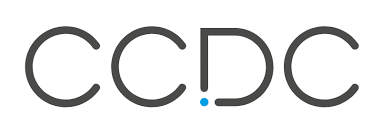 |
DAY SIX: Wednesday, August 4, 2021
New Data Updates, Subsets and Educational Tools from the Cambridge Crystallographic Data Centre (CCDC)
This webinar will discuss the latest updates from the CCDC, including database and software updates and new education and outreach efforts. We’ll present new subsets (like the MOF collection and Covid-19 subset), changes in the underlying database architecture and new partnerships. In addition, we have created new robust, online education tools to meet the needs of our user base. From home-friendly science festival activities to training videos and finally hands-on virtual training sessions that are easy to follow and engaging.
|
 |
DAY SIX: Wednesday, August 4, 2021
2.2.6 Economics of Crystallography
Session Chairs: Lee Daniels & Amy Sarjeant
Scientists cannot escape the restraint imposed by the cost of their research. This half-day session examines the past, current and future states of funding and profit in the world of structural science. The organizers encourage input from academia, industry, government and non-profit agencies in order to clarify the present and future of our science. Topics may include: How does funding drive the need and availability of crystallographic results? Why support crystallography? Funding a service lab, and justifying the cost. How does a contract research lab make the service economically feasible? Pharmaceuticals: What are the costs of exploring salts, co-crystals and polymorphs? What are the risks of NOT producing solid crystalline products?
|
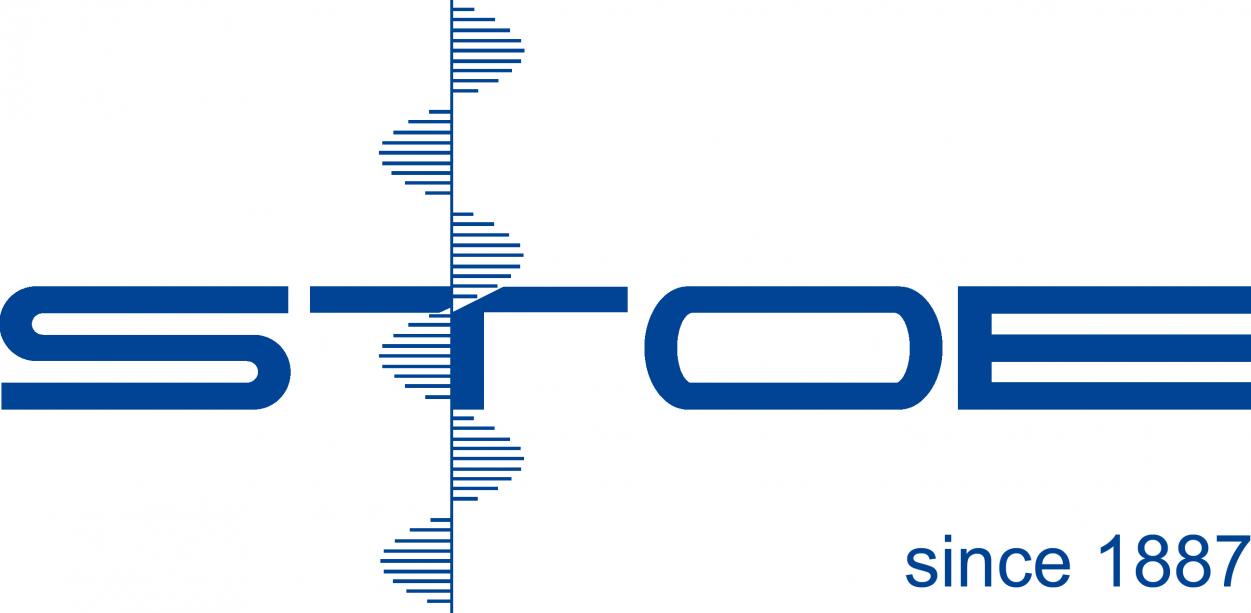 |
DAY SIX: Wednesday, August 4, 2021
3.1.5 What I Learned from My First Structures
Session Chairs: Silvana Urcia-Romero & Larry Falvello
This session aims to trace the development of the methodologies used in structure analysis in terms of the techniques applied by different generations of crystallographers. This will provide a developmental context for the technology, techniques and practices used today. The skills learned by each one of us for our first structure analyses serve as a time stamp for the starting point of our work in crystallography. The continual improvement of these techniques is chronicled by the changing practices in X-ray structure analysis. A high level of technical involvement by the user decades ago, and the accompanying imperative for the user to perfect all details of the results to the extent possible, have receded with the evolution of automated rapid-throughput analyses accompanied by quality control in the form of computerized validation. At the same time, analyses that were considered unfeasible years ago, involving twinning, modulation, ab-initio powder diffraction analysis and others, can be undertaken with relative ease today. That evolution of techniques and tools has also transformed the user's educational point of view, changing the emphasis in training from technical acuity with instrumentation, software, and fundamental crystallography itself, to a stronger focus on the results and their implications in a broader scientific context. Presentations will outline what has been achieved so far by past and present generations, including reference to fundamental details that are no longer considered explicitly. Submissions are welcome from all experience levels.
|
|




|
DAY SIX: Wednesday, August 4, 2021
3.1.1 Advances in Detector Technology
Session Chairs: Joseph Ferrara & Christopher Russo
The detection of X-rays, neutrons, and electrons for diffraction and imaging techniques has changed dramatically over the last 20 years. This half-day session will explore the most recent advances in detector technology as they apply to imaging and diffraction techniques.
|
|

|
DAY SIX: Wednesday, August 4, 2021
3.1.2 Complementarity Among Structural Methods
Session Chairs: Carlos Escalante
Recent advances in many structural biology techniques are allowing the study of more complex structures that were previously intractable. Moreover, the complementary of information provided by different techniques provides a better justification of the structure as it may integrate the static and dynamic information of a particular system. The aim of this session to present recent examples where a combination of techniques such as X-ray crystallography, SAXS, NMR spectroscopy, Cryo-Electron Microscopy among others, has been used successfully to tackle complex and dynamic structures of biological importance.
|
| |
DAY SIX: Wednesday, August 4, 2021
4.2.4 Self Assembly in Soft Matter Systems
Session Chairs: Tom Fitzgibbons & Volker Urban
Polymeric systems that are covalently bonded that exhibit poor compatibility will often self-assemble in ways to minimize the free energy of the system. This can occur in solution or though through a drying process towards the solid state. The self assembled structures play a key role in many applications ranging from lithography in electronic materials and nanotemplating to drug delivery vehicles and emulsion stabilization. Small angle X-ray and neutron scattering provide unique insight to the self assembled structures of block compolymers and amphiphilic. Advances in small angle scattering along with the accompanying modeling efforts have accelerated work in this field by providing insight into TH structures and phase transitions that occur in these systems. In this session, we will bring together experts in both experimental and modeling efforts associated with describing the self-assembly of polymeric systems and their associated phase transitions.
|
| |
DAY SIX: Wednesday, August 4, 2021
4.2.2 Meeting the Challenges of Raw Data Deposition
Session Chairs: John Rose & Wladek Minor
The ability reproduce experimental results (the basis of a publication or other scholarly work) strongly relies on the availability of primary experimental data. The Structural Biology community recognizes this and has encouraged the sharing of research data since its birth.
Today, the importance of archiving the raw data (the images and their associated metadata) leading to a structure has come to the forefront as reflected by the work of the IUCr and the ACA in this area. In addition, funding agencies are particularly interested in the reproducibility of the work they fund.
The speakers in the session will describe the crucial role that diffraction data may play in providing raw data needed for improving data reduction software leading to better structures, the re-determination of suboptimal macromolecular structures to improve structure quality and providing a reproducible platform for extending these analyses by future investigators.
|
 |
DAY SIX: Wednesday, August 4, 2021
Marilyn M. Olmstead Memorial Session
This session will honor the memory of Prof. Marilyn M. Olmstead and celebrate her extraordinary contributions to the field of X-ray diffraction. A longtime active member of the ACA, a perennial meeting attender, and a constant organizing force, Prof. Olmstead was a builder of networks and a champion of those without access to traditional resources. She mentored dozens of young and early career researchers from around the world, and she was a friend and confidant to many of her students and colleagues and their families. Prof. Olmstead's incisive mind, infectious enthusiasm, and tireless dedication will be greatly missed.
|
| |
DAY SIX: Wednesday, August 4, 2021
Innovations in Cryo-EM and Crystallography
Join MiTeGen's Joyce Frank and Ben Apker for an exciting webinar featuring some of the latest innovations in Cryo-EM and Crystallography including:
- Sample handling, transport and tracking for cryo-EM
- An innovative crystallography sample support system designed to be the next-generation crystal mounting system that will change how crystals can be prepared for X-ray diffraction data collection. Useful for Room Temperature, Single Crystal, and Serial Crystallography.
- Other recent developments
|
 |
DAY SEVEN: Thursday, August 5, 2021
AIP Oral History Program Overview
The Center for the History of Physics at the American Institute of Physics has made transcripts of over 1,600 oral history interviews available to the public, with more added to the collection every day. These interviews offer unique insights into the lives, works, and personalities of modern scientists, including prominent crystallographers like David Hass, Paul Peter Ewald, and Jenny Pickworth Glusker. Come learn about this invaluable resource, and our efforts to document the history of the physical sciences through scientists’ own words.
|
| |
DAY SEVEN: Thursday, August 5, 2021
3.2.3 Evolution and Impact of Targeted Protein Degradation in Industry
Chair(s): Matt Clifton & Joe Patel
Targeted protein degradation denotes the ability of a small molecule to catalyze the selective breakdown of a protein of interest via the ubiquitin-proteasome system (UPS). The ability to modulate protein levels offer a novel alternative paradigm to classical inhibitors and has been a major focus for both industrial and academic groups around the world. Structural characterization of these small molecule induced, non-cognate ternary complexes between the E3 ligase and protein of interest has presented unique challenges to advancing structure-based drug design efforts. This session will be dedicated to highlighting the significant structural advances that have been made in interrogating these induced complexes, insights into the structure-activity relationships of the small molecules, and the plasticity of the ligases to selectivity recognize disease relevant targets.
|
 |
DAY SEVEN: Thursday, August 5, 2021
3.2.4 Getting the First Crystal
Session Chairs: Sarah Bowman & Janet Newman
Crystallography needs high-quality, well-diffracting crystals – this is a rate limiting step in crystal based structure determination. In this session we will discuss screening strategies, developing new crystallization screens, seeding, modulating a protein construct to make it ‘more crystallizable’, strategies for membrane proteins, strategies for ‘seeing’ crystals, etc. Do you have a good ‘getting the first crystal’ story about a system you are working on? Do you have a strategy that works almost all of the time? We welcome submission of abstracts on these topics.
|
| |
DAY SEVEN: Thursday, August 5, 2021
3.2.5 Quantum Materials: Magnetism, Correlation, and Topology in Condensed Matter
Session Chairs: Jared Allred & Benjamin Frandsen
In quantum materials, non-trivial quantum mechanical states give rise to unusual macroscopic properties. Quantum materials stretch our understanding of the fundamental physics of materials and, in many cases, hold tremendous promise for eventual technological application. This class of materials includes topological materials, spin liquids, and other magnetic and/or correlated electron systems. The intriguing emergent phenomena observed in such systems can be heavily dependent on the physical structure, where even subtle details can have significant impact. This session will emphasize how crystallographic tools have been or can be used to uncover the structure-property relationship in quantum materials.
|
|





|
DAY SEVEN: Thursday, August 5, 2021
4.1.1 BioWAXS: Experiment & Interpretation
Session Chairs: Steve Meisburger & Jochen Hub
The molecules of life are in constant motion. To gain insight into dynamics on the atomic scale, it is increasingly common to apply wide-angle X-ray scattering (WAXS) to biomolecular solutions or condensed phases, especially in conjunction with time-resolved experiments. The WAXS signal is uniquely sensitive to dynamic structural fluctuations and hydration effects, both of which are key to a mechanistic understanding of function. However, the challenge of interpreting the WAXS signal has traditionally limited its biological applications. In recent years, the challenge has been addressed through a combination of new experimental techniques (such as temperature-jump and X-FEL) and sophisticated computational approaches (such as ensemble fitting, physics-based modeling, and machine learning). In this session, we aim to advance the field by highlighting recent experimental results and new methods for interpretation.
|
| |
DAY SEVEN: Thursday, August 5, 2021
All Members Business Meeting
|
|
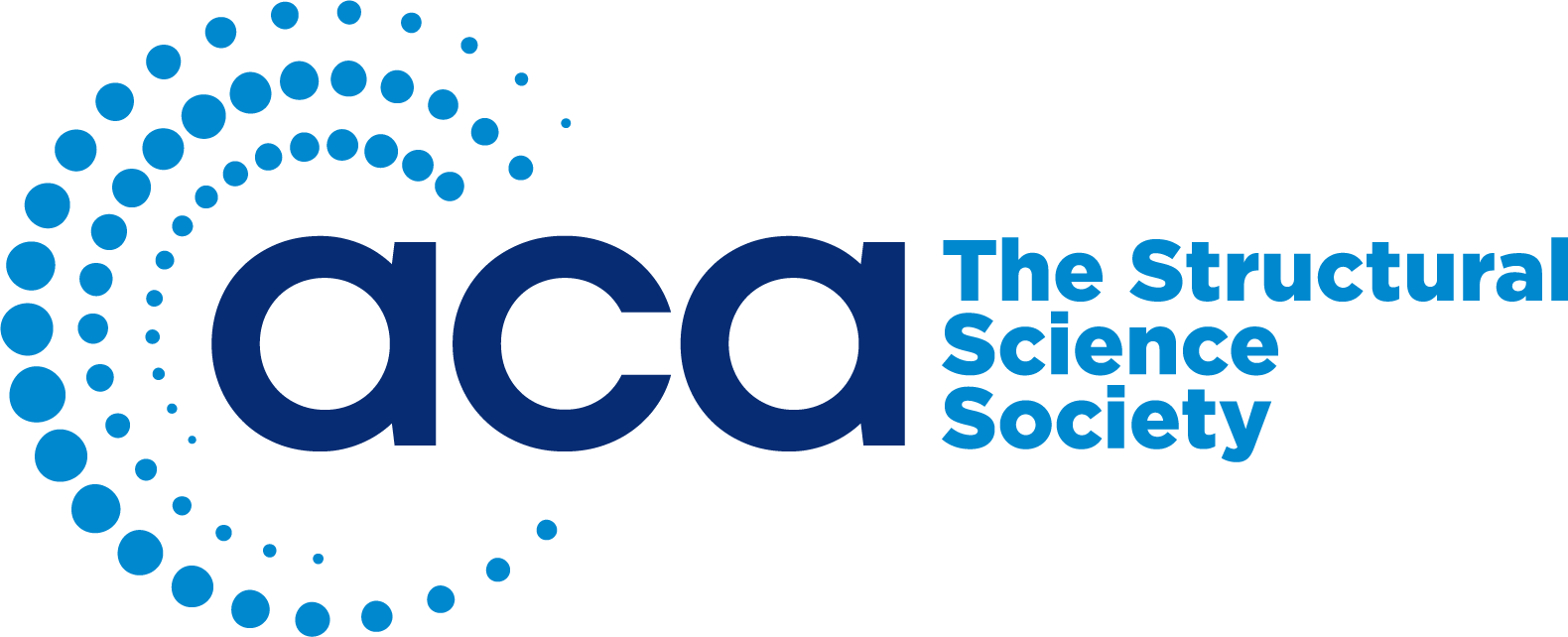
 Welcome to the 2021 ACA Annual Meeting Program. The scientific program features experts from all regions of the world.
Welcome to the 2021 ACA Annual Meeting Program. The scientific program features experts from all regions of the world. 







